by Ramesh Pokharel* (3/13)
Quick Facts…
- Nematodes are wormshaped, nearly microscopic animals, many of which are virtually invisible to the unaided eye when they are in the soil or within plant material.
- Many nematodes feed on bacteria and fungi in the soil and are, in turn, preyed upon.
- Nematode survival, growth, and reproduction depend largely on soil moisture, temperature in soil and/or host tissues, and availability of a food source or suitable host plant.
- Symptoms caused by most of the plant parasitic nematodes are difficult to distinguish from those caused by other soilrelated problems.
Nematodes are worm-shaped nearly microscopic animals, many of which are virtually invisible to the unaided eye when they are in the soil or within plant material. Of the known nematode species, approximately 50%, 25%, 15%, and 10% are free-living, marine, animal parasites, and plant parasitic nematodes (PPNs), respectively. Free- living nematodes are very important in maintaining the soil bio-dynamic system, especially in soil with low organic matter content, whereas PPNs feed on plants and reduce crop growth and yield efficiency. Free-living nematodes help in microbial colonization of substrates and mineralization of nutrients by disseminating microbial propagules throughout soil. In addition, nematode metabolites may also stimulate specific bacterial growth by releasing growth-limiting nutrients such as nitrogen (N) and vitamins. Many feed on bacteria and fungi within the soil and are, in turn, preyed upon by generalist predators (including the omnivorous and predatory nematodes). This improves nutrient cycling and allows slow release of nutrients. The contribution made by free-living nematodes to N mineralization (making N available to plants) and mineralization of other soil nutrients is relatively high compared to bacteria in soil ecosystems. These free-living nematodes also feed on other soil microbes including plant pathogens (bacteria, fungi, and nematodes). Free-living nematodes are important for Colorado soils for any crop production system. Another group, called Entomopathogenic nematodes (e.g., the genera Steinernema and Heterorhabditis), is extraordinarily lethal to many important soil insect pests and yet safe for plants and animals; they are used to control many soil inhabiting insects.
Eggs are laid in the roots or surrounding soil by the PPN females and hatch to produce wormlike larvae that usually go through four molts to reach maturity. Nematode survival, growth, and reproduction depend largely on soil moisture, temperature in soil and/or host tissues, and availability of a food source or suitable host plant especially for PPNs. Under favorable conditions, nematode reproduction will continue until the food supply is exhausted. However, nematodes can survive in poor soil conditions as eggs or larvae. Only a few PPN genera or species feed on aerial plant parts, while the majority of PPNs feed on underground plant parts such as roots, bulbs, and tubers. They feed on plant cells using a spear-like structure, called a stylet, which is distinct in most PPNs. They use these small, sharp, hollow structures to withdraw plant cell juice by sucking and thereby weaken the host plant. PPNs may be endoparasitic (remaining and feeding inside the cell), semi-endo or semi-ecto parasitic (body half inside and half outside the plant surface), and/or ectoparasitic (remaining and feeding from outside the plant cell).
In addition, feeding injury by these nematodes predisposes plants to injury from winter cold and/or spring frost (especially tree fruits), high soil pH damage, micronutrient deficiency, and to other disease, pest and weed problems. All of these are common problems in western Colorado. Conversely, poor crop nutrition, crop management, soil health status, and disease infections also may predispose plants to cold injury and nematode damage. The common PPN species associated with crops in Colorado are: root lesion (Pratylenchus spp.), bulb and stem (Ditylenchus spp.), foliar (Aphelenchoides spp.), dagger (Xiphinema spp.), root-knot (Meloidogyne spp.), lance (Hoplolaimus spp.), citrus (Tylenchulus spp.), spiral (Helicotylenchus spp.), ring (Criconemoides spp.), and stunt (Tylenchulus spp.). Most of them are important in one or more crops grown in Colorado. These nematodes alone or in combination with other factors reduce crop productivity. In addition, some PPNs including species of Longidorus (pin nematode), Trichodorus, Paratrichodorus (stubby-root nematode) and Xiphinema (dagger nematode) transmit plant viruses which are difficult to manage. These viruses and/ or the nematodes weaken the plants to the point that they are more easily killed by other causes such as disease, insect, cold, or other stress factors common to Colorado conditions. Feeding by a large nematode population on a plant root system interferes with the roots’ ability to take up water and minerals and to transport nutrients to the shoot. This restricts root growth, reduces plant vitality, and inhibits/retards shoot growth; the combination of these results in decreased crop quality and/or yield. In addition to direct plant injury from nematode feeding activities, nematodes are thought to inject injurious substances into the plant when they feed. Symptoms caused by most of the plant parasitic nematodes are difficult to distinguish from those caused by other soil-related problems. Thus, nematode identification based on symptomology is difficult.
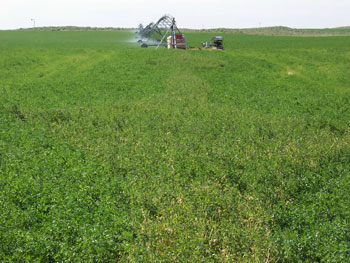 Figure 1. Plants in yellow patches are severely infected by alfalfa stem nematodes in a field. Figure 1. Plants in yellow patches are severely infected by alfalfa stem nematodes in a field. |
What they do in plants (symptoms and injury):
- non-uniform plant growth–mostly in patches and poor plant establishment resulting in an unhealthy appearance (Fig. 1)
- plants weakened over time and killed when combined with other problems
- chlorosis and stunting (resembling symptoms of some virus infections or micronutrient deficiencies)
- knots (galls), lesions on roots, stubby roots or root bifurcations–may confuse with nitrogen-fixing bacteria on the roots of legumes
- excessive branching of roots and hairy root symptoms
- poor root health, growth and establishment
Although hundreds of different nematode species are associated with plants, not all are plant parasites. And, in many cases, PPN populations occur in numbers too small to cause serious plant injury. Nematodes from soil samples or infected plant parts must be extracted, identified, and counted in order to determine if one or more nematode species [and which one(s)] is (are) causing poor plant growth. Knowing the number of PPNs present helps to determine the control strategies. If the population level is high enough to cause economic damage (i.e., at or above the ‘economic density threshold’ for that species), then application of control strategies is recommended. The following table gives a general economic threshold level for eight different important nematodes found in Colorado soil. However, these numbers may need adjustment when other variables are considered because density thresholds vary with crop, location, soil type and cropping history. For example, density thresholds for economic damage to peach in clay loam to clay soils would be >39 ring nematodes, >99 root knot nematodes, and >49 dagger nematodes per 100 milliliters 100(ml) of soil; this will be different in other soil types and for other crops.
| Organism | Threshold | Organism | Threshold |
| Root lesion nematode general | 500-1000 | Spiral nematode | 300-500 |
| Root lesion nematode in dry bean | >250/root | Alfalfa stem nematode | >1000 |
| Dagger nematode | 50-100 | Root-knot nematode | 100 |
| Lance | 40-150 | Stunt nematode | 150-300 |
| Ring nematode | 250-600 | Citrus nematode | 10-100 |
Important Plant Parasitic Nematode Genera in Crops
Aerial Feeders:
Foliar feeder (Aphelenchoides spp.): It is one of the few plant-parasitic nematodes which live in and damage leaves, buds, and other soft above-ground plant parts rather than roots. Foliar nematodes have broad host ranges and are capable of infecting hundreds of plant species. However, severity varies with host, environment, and the nematode species. Leaf crinkling and distortion and dwarfing of the plant, with associated reduction in flowering on various plants including strawberry and chrysanthemum, cause reduction in plant vigor; damage to lawn grasses also is reflected by a reduction in plant vigor. In ornamental plants, the most distinctive field symptom of foliar nematodes is the presence of lesions (off-colored areas in foliage) bounded by the major veins in leaves. This nematode is found in high numbers in some places in these crops grown in Colorado. The nematode enters and leaves the host plants by natural openings and must have free moisture on the leaf surfaces to move about.
Bulb and stem feeder (Ditylenchus spp.): There are two important species in commercial crops: Ditylenchus dipsaci and Ditylenchus destructor.
Ditylenchus dipsaci: This is one of the most devastating plant parasitic nematodes, especially in temperate regions. It is known to have more than 10 biological races, some of which have a limited host range while others infect over 450 different plant species, including many weeds. The principal hosts are alfalfa, faba (fava) beans, onion, garlic, leek, maize, oat, pea, potato, rye, strawberry, sugar beet, tobacco, bersem, clover, and tulip. It has also been reported on carnation, celery, lentil, rape, parsley, sunflower, and wheat. It is found almost everywhere that these crops are grown with variable severity.
Figure 2. White flagging symptions caused by Ditylenchus in alfalfa.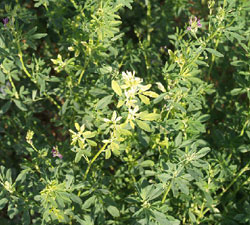 |
D. dipsaci is a migratory endoparasite that feeds upon parenchymatous tissue in stems and bulbs, causing the breakdown of the middle lamellae of cell walls. Feeding often causes swellings and distortion of aerial plant parts (stems, leaves, flowers) and necrosis or rotting of stem bases, bulbs, tubers and rhizomes that begins in the field and continues in storage. In onion plants at 59 ° F (15 ° C), the life-cycle takes about 20 days. Females lay 200 to 500 eggs each. Fourth-stage juveniles tend to aggregate on or just below the surface of heavily infested tissue to form clumps of “eelworm wool” and can survive under dry conditions for several years; they may also become attached to the seeds of host plants (e.g. onions, lucerne, Trifolium pratense, faba beans, Phlox drummondii). In clay soils, D. dipsaci may persist for many years. Cool, moist conditions favor invasion of young plant tissue by this nematode. Alfalfa plants tend to be stunted with very small ‘mouse-eared’ leaves, stems with shortened internodes and swollen nodes and with pale yellow or white shoots (often called white flagging, Fig. 2). This symptom is readily observed at green-up in the early spring or just after the first cutting. Infected stems are brittle and tend to break off from the crown, and infected crowns are not firm and may be spongy in consistency. Infected areas of the field are about 2-3 weeks slower to green-up in the spring compared to non-infected areas and appear to have winter kill. Plants will die and the stands become patchy with blank spaces. Stand decline increases weed pressure within affected fields. We observed high incidence of other soilborne fungal pathogens such as Rhizoctonia associated with alfalfa affected with alfalfa stem nematode in sandy soil.
In onion, nematode penetration into the leaves causes leaf deformation and leaf swellings or blister-like areas on the surface; leaves grow in a disorderly fashion, are often wilted and chlorotic; and high nematode numbers can actually kill younger plants. The bulb inner scales are usually more severely damaged than the outer scales, the bulbs soften and show the scales in concentric circles when cut open. In garlic, leaf yellowing and death occur without any leaf deformation or swelling. It can be carried on dry seeds and planting material of host plants. In the field, fourth-stage juveniles can withstand desiccation for many years with gradually decreasing survival over years without a host plant. Nematode survival and damage are greater in heavy soils as compared to sandy soils. The nematodes are spread to new areas by surface water runoff, irrigation, wind-blown crop debris, soil and crop debris clinging to equipment, humans and livestock, and with seed. Runoff water is very important in the spread of stem nematodes within a field and to adjacent fields.
Ditylenchus destructor infects potato and can’t withstand desiccation (unlike D. dipsaci), so it is usually important only in cool, moist soils. Without a resistant resting stage, this species overwinters in soil as adults, larvae, or possibly as eggs; it may even multiply in warmer winters by feeding on alternative weed hosts and/or on fungal mycelium. The eggs hatch in the spring, and larvae are immediately able to parasitize hosts. At 82 ° F (28 ° C) egg hatch begins 2 days after egg laying, with an average interval of 4.4 days between egg laying and hatch; development from egg to adult takes between 6 and 7 days. The nematode infects only subterranean not aerial parts of plants. They enter potato tubers through the lenticels, and then begin to multiply rapidly and invade the whole tuber. They can continue to live and develop within tubers in storage.
No obvious symptoms are seen in the aerial plant parts, although heavily infested tubers give rise to weak plants which usually die early in season. Small, off-white spots in the otherwise healthy flesh are characteristic symptoms of early infections that can be detected by peeling the tuber. These spots enlarge, darken, are woolly in texture, and may be slightly hollow at the center. Slightly sunken, cracked, and wrinkled skin can be detached in places from the underlying flesh on badly affected tubers. The flesh has a dry, grayish to dark brown or black appearance. This discoloration is largely due to secondary invasion of fungi, bacteria and free-living nematodes. D. distructor also infects iris, tulip, and peanuts.
Root Feeders:
Root-lesion Nematode (Pratylenchus spp.): This is the most common genus of plant parasitic nematodes observed in Colorado crops and has a very wide host range from row crops, vegetables, and ornamentals to tree fruits. In onion fields, it has been observed in high numbers, especially in areas with sick looking plants or a history of poor performance. Damage from this nematode may be severe in onion fields rotated with corn as it infects both corn and onion. In fruit orchards, this nematode can be a major cause of orchard replant failures. Very high numbers of this nematode were observed in Colorado in turf greens with patches of yellow plants. It can be a major problem in potato, grape, wheat, and corn, especially in crops planted in light soils. Lesion nematodes (Pratylenchus neglectus and P. thornei) occur high in numbers in many non-irrigated fields of the Pacific Northwest, reducing yield as much as 70% in susceptible spring wheat varieties with little or no visual symptom expression in the crop canopy other than a generally unthrifty appearance. P. neglectus was observed in 70% of wheat fields surveyed in Colorado whereas P. vulnus is the most common root lesion nematode in fruit crops, causing damage in apple, peach, cherry, and grapes.
A large number of lesion nematodes in a root frequently cause the root to turn brown and die, a common symptom of infection. However, roots of some plants are not sensitive and do not turn brown. In addition to the death of root cells caused directly by the nematode movement and feeding, wounds resulting from nematode activity allow other soil microorganisms to enter the root tissues and contribute to root rot and decay. All mobile stages of root lesion nematode enter the root and burrow tunnels through the root cortex. Eggs laid inside root tissues or in the soil hatch, and emerging juveniles enter or remain in the roots and cause root injury. Root lesion nematodes are migratory and therefore are capable of repeatedly entering and exiting from root tissue, although several generations can occur inside the roots without the nematodes migrating into the surrounding soil. These nematodes cause small brown lesions on the white lateral roots and kill the fine feeder roots. The entire root system appears discolored when these lesions merge. Severely affected plants, especially trees, may lose all feeder roots. This nematode is a serious problem in orchard replant sites as it causes replant disease where young replanted trees grow poorly and may die and where existing trees lack uniformity. If not dead, the top part of the infected tree often exhibits stunting, chlorosis, and twig dieback with a decline in vigor, especially in peach and cherry orchards.
Dagger Nematode (Xiphinema spp.): One of the largest PPNs (Fig. 3 left), this nematode causes direct damage to a wide variety of plants by its feeding activities and several dagger species also transmit soil-borne plant viruses. This virus transmission is especially important to fruit crops in Colorado as many important and common fruit viruses are involved. In Colorado orchards this nematode is commonly observed in almost all fruit crop types, rootstocks, locations, and soil types. Females lay eggs singly in the soil near plants and they hatch to produce first stage juveniles. Males are rarely observed. Dagger nematodes typically have 3-4 juvenile stages, require 6 to 12 months to complete their life cycle, and may live up to 3 years under favorable soil conditions.
Figure 3. Left: Adult dagger nematode (Xiphinema sp.: note long body) with photo-insert showing the characterisitc long stylet with basal flanges. Right: Leaf enations on the lower side of cherry leaves due to Cherry Rasp Leaf virus infection.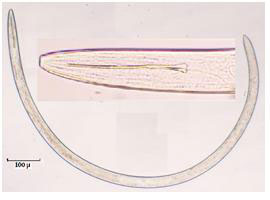 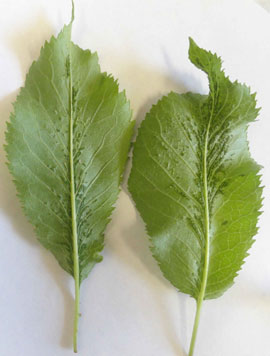 |
Dagger nematode densities observed in most western Colorado apple orchards (18-152 nematodes/100 ml soil) are above the economic threshold level for apple (10-100 nematodes/100 ml soil). However, economic threshold levels are not known for other crops. Ectoparasitic dagger nematodes do not burrow into roots, but insert their long stylet deep into root tips where they feed on root tip cells. Dagger nematode feeding causes some necrosis and stunting and swelling of root tips. Several lateral roots may appear above the damaged root tips. Root-tip swelling may be confused with the galls of root-knot nematodes. Daggar nematodes also can cause damage to many other crops, especially if the population is high.
Eleven species of dagger nematode are known to transmit 13 important fruit NEPO viruses. Cherry Rasp Leaf Virus (CRLV) (Fig. 3), an important and common problem in western Colorado cherry orchards, is transmitted by the X. americanum dagger nematode species complex. The same complex also causes Flat Apple Disease in apple which is not as serious as CRLV problem in western Colorado. Another virus vectored by X. rivesi and X. americanum is Tomato Ring Spot Virus (TmRSV), which causes Prunus Stem Pitting (PSP). According to unpublished information X. thorneii and X. utahensis are present in Colorado. Dagger nematode populations observed in western Colorado cherry orchards (15-70 nematodes/100 ml soil) are very high as 1 nematode/100 ml soil is enough to transmit CRLV. The identification of species found in Colorado is in progress. Some other important fruit viruses transmitted by dagger nematode are: Grapevine Fan Leaf Virus, Grapevine Yellow Vein Virus, Tobacco Ring Spot Virus, Peach Rosette Mosaic Virus, and three strains of TmRSV causing Peach Yellow Bud Mosaic, Prune Brown Line, and Prunus Stem Pitting. The viruses are acquired within 24 hours of the initiation of feeding and are carried in the esophagus lumen for up to 12 months. Virus particles are transmitted by both adults and juveniles.
Figure 4. Spiral nematode (Helicotylenchus sp.) adult showing the characteristic spiral body shape with a stout tail and a short, stout stylus.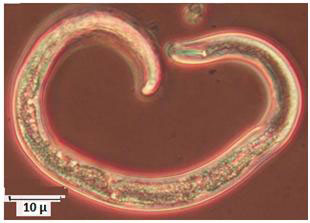 |
Spiral nematode (Helicotylenchus spp.): This commonly observed nematode is often found in higher numbers (compared to other nematodes) in soils associated with all crops grown in Colorado (Fig. 4). Spiral nematodes may contribute to stress on corn, soybeans, and other row crops during hot, dry weather, but rarely cause yield loss even at high population levels. This nematode is important for dry land cropping. Spiral nematodes feed at or near the root tips causing devitalization, the most severe type of root injury, and induce stubbiness to primary and lateral roots and coarse root systems lacking feeder roots. They may contribute to stress on plants, especially when present in high number. This nematode is seldom considered important as it does not cause serious crop loss. However, it may be important for Colorado crops as it was found in high numbers and because Colorado has many other stress factors. Spiral nematodes generally are ectoparasites, but some are semi-endoparasites and a few are endoparasites. Ecto and semi-endo-parasites lay their eggs in soil near the roots, whereas endoparasites lay eggs inside the roots. This genus, with 186 species reported, has a wide host range including lawn grasses, boxwood and other ornamentals, corn, soybean, and tobacco; but only four species are associated with growth suppression of plants.
Root-knot nematode (Meloidogyne spp.): This nematode species is a major concern for almost all crops grown in light soils. In Colorado it is a problem in potato, onion (especially in sandy soil), fruit orchards, and many row crops. Root-knot nematode is a sedentary endoparasite; larvae feed in roots and reduce crop productivity. Eggs laid in a gelatinous matrix can survive in soil for a long time and hatch when environmental conditions are favorable. Root-knot nematodes can go from egg to reproducing adult (complete life cycle) in as little as 3 to 4 weeks (Fig. 5, left).
Figure 5. Left: Meloidogyne larvae (A), young female (B), and mature female (C) showing body shape. Right: damage in radish (A) by infection in growing roots early in season, and root galls in tomato caused by root-knot nematode (B). Photo B was provided by Dr. Harold Larsen.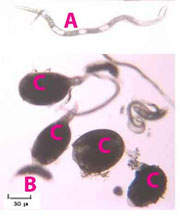 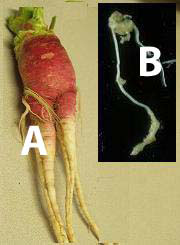 |
Larvae penetrate and feed inside roots while males are sterile and do not cause damage. Nematode feeding may cause death of growing tip and cause branching (Fig 5 right, A), and/or root cells around the female nematode react by dividing many times and enlarging to produce a gall (Fig 5 right, B ). Depending on the particular root-knot nematode species, the susceptibility of the host plant, and the numbers of infecting nematodes, root galls may vary in size from 1/8 of an inch to 1 or more inches in diameter. At high population levels, most of the roots become galled. As the female nematode feeds inside the root, the gall enlarges and becomes spherical; 15 to 30 days after infection, the female lays 200-500 eggs in a mass attached to her body. Root galls are easily seen, and root-knot infected plants can be recognized easily by uprooting plants and looking at the roots (Fig. 5, right). However, root galls often are easily detached and left behind in the soil when pulling up plants and even by water pressure during washing. There are four important species of Meloidogyne that attack many hosts including fruits, but they are more problematic in hot climates than cool climates.
Ring nematode (Criconemoides spp.): Several species of Criconemoides and related genera are found to affect crop plants, especially fruit crops. They are small, cigar-shaped, strictly ectoparasitic nematodes (Fig. 6) that feed on the surface of the root and cause browning on tender tissues. They are of low importance to most crops, but can contribute to serious decline or total failure of peach and nectarine grafted on susceptible rootstocks. Criconemoides is commonly observed in many different fruit orchards (including peach) in Colorado, especially those with sandy or light soil types. The life cycle takes 25-35 days. After feeding for several days on roots, females deposit single eggs every two to four days. Second stage juveniles (J2) hatch from the egg in 11-15 days, molt to J3 in three-five days, molt to J4 in four-seven days, and become adults five-six days later. Males are almost never observed.
Figure 6. Adult ring nematode (Criconemoides xenoplax). Note the stout body shape with heavy annulations (rings) of cuticle and stout stylet. (Photo by Dr. Harold Larsen).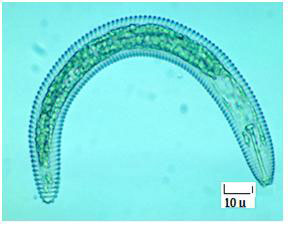 |
Ring nematodes cause more severe damage in coarse textured than in fine textured soils. Optimum conditions for reproduction include a pH near 7 and soil temperatures of 75-80 ° F (24-27 ° C). Ring nematodes appear to be sensitive to low soil moisture and low pH. The ring nematode, Criconemoides xenoplax, has been linked to peach tree short life (PTSL) disease complex, cold injury and/or bacterial canker (Pseudomonas syringae). It is a widespread problem in peach production in Georgia and South Carolina, but has not been associated with production in Colorado even though high populations of this nematode were observed problems associated with many orchards. However, the potential for yield reduction caused by this nematode in fruits should not be ignored. Monitoring of crops such as tree fruits, especially in light soil, is essential to avoid economic losses from this nematode.
Lance nematode (Hoplolaimus galeatus): This nematode parasitizes a wide variety of hosts such as wheat, corn, bean, pea, cabbage, sweet potato, peanut, chrysanthemum, apple, clover, alfalfa and lawn grasses; but it is more damaging in grasses and tree fruit crops. In our surveys, high numbers of this nematode were observed with tree fruits, alfalfa fields, and lawn grasses in some areas in Colorado (Fig. 7).
Figure 7. Patches of necrotic/dead plants in a lawn associated with high populations of lance nematode (Hoplolaimus spp.).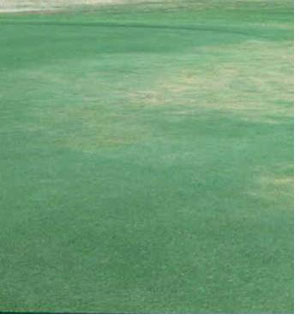 |
This is a serious pest of home lawns and golf greens. It is found in Canada, Sumatra, India, Tanzania, and Central and South America, and the U.S. In the U.S., it is common along the East Coast from New England to Florida, within the Mississippi River basin (Minnesota, Wisconsin, Louisiana, and Colorado), and in California and Texas. Many trees, crops and grasses are subject to damage, including cotton, pine, oak, wheat, corn, bean, banana, pea, cabbage, sweet potato, peanut, chrysanthemum, sycamore, apple, clover, alfalfa, and lawn grasses. This nematode is associated with severe stunting and reduction in plant vigor of alfalfa.
Citrus nematode (Tylenchulus spp.): This semi-endoparasitic nematode causes severe damage (slow decline) in citrus crops and can be a problem in grapes, olive and apple. In our surveys Tylenchulus was commonly observed in apple orchards in Colorado. Second stage juveniles, especially females, are infective. Juveniles partly invade roots, feed there, and become females which protrude from the roots, with the exposed part of the mature female body becoming enlarged on the surface of the roots. This nematode causes aerial symptoms similar to nutrient deficiencies and produces dirty roots. The damage due to Tylenchulus nematode is higher in areas with soils having a high pH, like those found in Colorado. It reduces tree productivity by damaging the root system of fruit trees, especially apple.
Management
Nematode management must focus on reducing nematode numbers to levels below the damage threshold rather than eradication. However, nematode management is important as they are a predisposing factor to soil borne pathogen infection and environmental stresses such as injury from winter cold, spring frost, or salinity damage, and/or micronutrient deficiency. Young females are the damaging state, not the males.
- Large populations of free-living nematodes can help control many different PPNs in the soil, so provide enough organic matter to increase free-living nematode populations. If your soil does not have enough free-living nematodes, add soil with a higher number of free-living nematodes and provide food (organic matter) to sustain these nematodes.
- Marigold, sudan grass and Brassica spp. can be used as green manure crops to control PPNs and boost free-living nematode populations in the soil. Glucosinilate or isocthiocyanate content in many Brassica species is known to control many PPNs.
- Soil solarization is very effective for control of many nematodes and other soil-borne pathogens. For soil solarization: plow the field to ensure looseness, then ensure adequate moisture, cover with plastic, seal the plastic to make it air tight, and maintain the seal for at least 45 days during June and July. A combination of options 2 and 3 should be more effective. Soil solarization, however, may not be effective if the nematodes are deep in the soil as these nematodes from deeper layer might come back by plowing.
- Chemical treatments include DiTera ES at 5-40 gal/A, DiTera DF at 13 – 100 lb/A, DiTera WDG at 13 – 100 lb/A or apply DiTera ® WP or DiTera® ES, a liquid formulation before planting or to foliage of growing plants (check the label for foliar spray). This is good option for organic growers. Preplant soil fumigation options include Telone® C-17 at 11 – 17gal/A, Telone® II at 9 – 15 gal/A, Vapam (metam sodium ) at 40 – 100 gal/A, or Basamid 99G (dazomet) at 222 – 350 lb/A. Apply soil fumigants when the soil temperature is 50 – 80 ° F at 6” soil depth with appropriate field moisture. These conditions are critical to get effective results. Covering soil after application of the soil fumigant increases efficacy of the treatments. [Note: soil fumigants typically are restricted and are available only to certified applicators.]
- Host resistance: Many rootstocks are reported to have tolerance or resistance to PPNs. In grape, rootstock 9407-14 is resistant to many PPNs. Peach rootstocks resistant to nematodes include Nemagard (root-knot nematode) and Guardian (root-knot and ring nematodes). Adaptive studies of such rootstocks to our local condition are underway. Grape rootstocks Schwarzmann and Freedom were rated as resistant against X. index.
- The integrated use of bio-fumigation is under study in Western Colorado, especially targeted to replant disease.
References
Mai, W. F. and P. Mullin. 1975. Plant-Parasitic Nematodes. A Pictorial Key to Genera. Fourth edition. Comstock Publishing Associates, A division of Cornell University Press, Ithaca, and London. 277 pp.
Niles, R. K and G. A. McIntyre, 1997. Colorado plant pathogenic nematode survey 1996-1997. Colorado State University. Fort Collins. 20 pp.
Pokharel, R. R. and H. J. Larsen. 2007. The importance and management of phytoparasitic nematodes in western Colorado fruit orchards. J. of Nema. 39: 96.
Pokharel, R. and H. J. Larsen. 2008. Plant parasitic nematodes associated with fruit crops in western Colorado. Pp. 22-28 In: Godin, R. (ed.). Western Colorado Research Center Annual Report – 2007, TR 07-08, Colorado State University – Agric. Res. Sta., Colorado State University. Ft. Collins. 76 pp.
Pokharel, R. R. H.J. Larsen, B. Hammon, T. Gourd and, M. Bartolo. 2009. Plant parasitic nematodes, soil and root health in Colorado onion fields. In: Godin, R. (ed.). Western Colorado Research Center, Colorado State University. Annual report, TR 09-12:39-44.
Pokharel and B. Hammon. 2008. Plant parasitic nematodes associated with Alfalfa in Colorado. Research Report submitted to Forage Genetics group.
* Ramesh Pokharel, Colorado State University, Western Colorado Research Center. (5/11)
Colorado State University, U.S. Department of Agriculture, and Colorado counties cooperating. Extension programs are available to all without discrimination. No endorsement of products mentioned is intended nor is criticism implied of products not mentioned.
Go to top of this page.





